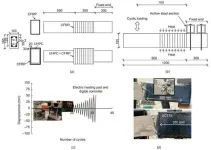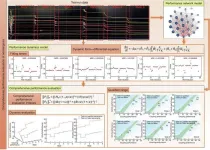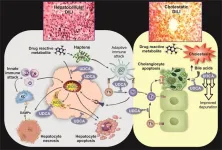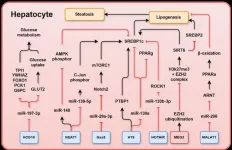(Press-News.org) Virginia Tech is spearheading a research coalition to reveal the untapped potential of the greater Appalachian Mountains region.
This coalition aims to accelerate the identification and characterization of unconventional critical mineral resources throughout the area. It brings together academic institutions, research laboratories, federal and state natural resource offices, and consultancies, all collaborating with the end goal of boosting regional economic growth and creating new jobs.
The research team, led by Richard Bishop, professor of practice in the Department of Mining and Minerals Engineering and researcher in the Virginia Center for Coal and Energy Research, will be funded through a $7.5 million grant from the U.S. Department of Energy. The project also includes more than $2 million in cost share from project partners and industry stakeholders, bringing the total project to nearly $10 million.
This initiative is part of the Department of Energy's Carbon Ore, Rare Earth, and Critical Minerals (CORE-CM) program, which seeks to establish regional coalitions focused on accelerating the development of critical mineral supply chains from unconventional resources.
Named Expand Appalachia CORE-CM, this project is part of a broader federal effort to reduce dependence on imported critical minerals and support the development of domestic supply chains. This initiative aims to help advance cost effective and environmentally responsible processes to produce and refine critical minerals and materials in the United States.
“We're identifying critical minerals that can be recovered from unconventional resources,” said Bishop. “By unconventional, we mean innovative sources that haven't been fully explored or considered before. These critical minerals are essential for alternative energy applications, such as solar panels and electric vehicles, as well as for components in modern electronics like smartphones, batteries, and semiconductors.”
The Expand Appalachia project builds on Bishop’s previous $2.71 million Department of Energy project, Evolve Central Appalachia. It aimed to develop strategies to enable the Central Appalachia coal basin to realize its full economic potential in producing rare earth elements, critical minerals, and high-value, nonfuel, carbon-based products. The study prioritized a geographic region that primarily included southern West Virginia, eastern Kentucky, eastern Tennessee, and southwest Virginia.
The Evolve Central Appalachia team collected and analyzed more than 700 geologic and mine waste samples to make an initial assessment of the regional potential for rare earth element and critical mineral production. Team members also prioritized stakeholder engagement, giving more than 50 outreach and educational presentations over a 2 1/2-year period.
The Expand Appalachia project follows a similar approach but will expand both the geographic scope and the type of resources under consideration. The new region of study spans 11 states throughout the greater Appalachian region from Tennessee to Maine. Working with project partners and industry collaborators, the team will collect and analyze various material and legacy mine waste samples to characterize mineral structure and concentration levels. Targets will include both coal and non-coal resources as well as power generation facilities and other unconventional critical mineral sources throughout the region.
The objectives of this project are to:
Identify the amount and location of critical mineral resources in the region
Develop strategies to use existing infrastructure, industries, and businesses to drive economic growth
Create and execute plans to educate and involve community stakeholders
Prepare and begin implementation of a workforce development plan to train future technicians, skilled workers, and STEM professionals
Develop plans to establish regional technology innovation centers
The research team will assess regional infrastructure, including abandoned mines throughout the region, and identify industries that could benefit from production. Many coal-producing communities in Appalachia have seen a downturn, but the grant from the Department of Energy could supply fresh jobs. The research team will develop strategies to boost economic growth, close supply chain gaps, attract investment, and enhance workforce education and training.
“The great thing is that we've united as a region, bringing together experts in critical mining and mineral processing from industry and various universities to tackle the challenge of sourcing in-demand minerals,” Bishop said. “The supply chain of these minerals is at risk, so we're assessing domestic sources to determine their locations and concentrations.”
The Expand Appalachia project team partners are:
Virginia Tech
University of Kentucky
Penn State
West Virginia University
Bluefield State University
Marshall Miller & Associates
Bandy Geological
Virginia Department of Energy
Kentucky Geological Survey
Crescent RI
Chmura Economics & Analytics
Gray Energy
Coalfield Strategies
US Geological Survey
“For many years, the Virginia Tech Mining and Minerals team has been a national leader in the area of rare earth and critical mineral production and is committed to work that improves the lives of our friends and neighbors through Appalachia,” notes Aaron Noble, Department Head of Mining and Minerals Engineering and project co-principal investigator. “I am excited to see how this new project will advance our efforts and expand our opportunities to secure domestic production of these critical resources.”
“It is crucial to our national and economic security that the U.S. identify secure sources of critical minerals. I am proud to see Virginia Tech playing a leading role in critical minerals research, leveraging natural resources found right here in the commonwealth.”
-U.S. Sen. Mark Warner
"Critical minerals are essential for many of today’s technologies, especially those related to clean energy. I’m glad Virginia Tech is receiving federal funding I helped secure to research critical mineral extraction and processing in the Appalachian region. This will provide opportunities for new industries to develop, which will grow the local economy."
-U.S. Sen. Tim Kaine
“The work at the Virginia Center for Coal and Energy Research has led to exciting breakthroughs in tapping from coal beds sources of the rare earth minerals so integral to modern technology, used in everything from advanced batteries to smartphones. DOE’s award advances research that could support jobs in Appalachia and shore up supply chains vital to our country’s security and economic growth.”
- U.S. Rep. Morgan Griffith
END
Virginia Tech to lead $10 million critical mineral research coalition in Appalachia
2025-02-28
ELSE PRESS RELEASES FROM THIS DATE:
CFRP and UHPC: New insights into strengthening reinforced concrete beams under thermocyclic distress
2025-02-28
A recent study published in Engineering delves into the behavior of reinforced concrete beams strengthened with Carbon Fiber Reinforced Polymer (CFRP) and Ultra-High-Performance Concrete (UHPC) under thermocyclic loading. This research, conducted by Ju-Hyung Kim and Yail J. Kim, aims to understand the effects of multi-hazard loading on these strengthened structures, which is crucial for the maintenance and rehabilitation of existing buildings.
Multi-hazards, such as the combination of seismic events and high temperatures, pose ...
Armsworth receives SEC Faculty Achievement Award
2025-02-28
Paul Armsworth, Distinguished Service Professor in the Department of Ecology and Evolutionary Biology at the University of Tennessee, Knoxville, has received a 2025 Southeastern Conference Faculty Achievement Award for excellence in teaching, research and service.
He and the 15 other recipients this year — one from each SEC member university — are now nominated for the SEC Professor of the Year Award, which will be announced later in the spring.
“I am thrilled to receive this recognition, but it is also very humbling to be celebrated in this ...
Novel network dynamic approach presents new way for aeroengine performance evaluation
2025-02-28
A recent study published in Engineering presents a groundbreaking method for comprehensively evaluating the performance of aeroengines, the crucial components powering aircraft. Authored by Shubin Si and other researchers from esteemed institutions in China, this research addresses long-standing challenges in aeroengine performance assessment.
Aeroengines are complex systems, and their performance directly impacts flight safety and efficiency. Traditional evaluation methods, such as airlines relying on single-parameter indicators like exhaust gas temperature or manufacturers conducting ...
Gene therapy developed for maple syrup urine disease shows promise, new UMass Chan study reports
2025-02-28
A study led by UMass Chan researchers demonstrated that a gene therapy to correct a mutation that causes maple syrup urine disease (MSUD) prevented newborn death, normalized growth, restored coordinated expression of the affected genes and stabilized biomarkers in a calf as well as in mice.
“Simply put, we believe the gene therapy demonstrated in both animal species, especially in the cow, very well showcases the therapeutic potential for MSUD, in part because the diseased cow, without treatment, has a very similar metabolic profile as the patients,” said Dan Wang, PhD, assistant ...
Ursodeoxycholic acid for the management of drug-induced liver injury: Role of hepatoprotective and anti-cholestatic mechanisms
2025-02-28
Drug-induced liver injury (DILI) is a significant concern in clinical practice, arising from medications, herbs, and dietary supplements. It can manifest in different forms, including hepatocellular, cholestatic, and mixed types, each associated with specific liver enzyme abnormalities and histological injury patterns. Hepatocellular DILI is characterized by inflammation, necrosis, and apoptosis, while cholestatic DILI involves bile plug formation and bile duct paucity. Ursodeoxycholic acid (UDCA), a widely used treatment for cholestatic liver diseases, has recently been investigated for its potential therapeutic effects ...
Hepatic biliary adenofibroma: Histological characteristics, diagnostic challenges, and its role as a precursor to intrahepatic cholangiocarcinoma
2025-02-28
Hepatic biliary adenofibroma (BAF) is a rare benign bile duct neoplasm that has garnered increasing attention due to its potential role as a precursor lesion for intrahepatic cholangiocarcinoma (iCCA). Although it shares histopathological features with other biliary tumors, BAF is distinct in its composition, consisting of low-grade tubuloglandular and microcystic bile duct structures embedded in a dense fibrous stroma. Despite its classification as a benign tumor, emerging case reports suggest that BAF may undergo malignant transformation. However, its rarity and limited molecular characterization contribute to diagnostic ...
Unlocking the role of long non-coding RNAs in liver disease progression
2025-02-28
Metabolic dysfunction-associated steatotic liver disease (MASLD), formerly known as non-alcoholic fatty liver disease (NAFLD), is a global health challenge, affecting nearly 30% of adults worldwide. A significant subset of MASLD patients progresses to metabolic dysfunction-associated steatohepatitis (MASH), liver fibrosis, and even hepatocellular carcinoma (HCC), yet no universally approved treatment exists outside resmetirom. The increasing prevalence of MASLD, driven by obesity and diabetes, highlights an urgent need for innovative therapeutic ...
McMaster researchers uncover blood metabolites that may influence early childhood development
2025-02-28
McMaster University researchers have identified small molecules in the blood that may impact early childhood development, showing how dietary exposures, early life experiences, and gut health can influence a child's growth and cognitive milestones.
A McMaster team collaborated with Brazilian scientists to conduct an untargeted metabolomic analysis of blood samples taken from more than 5,000 children between the ages of six months and five years as part of the Brazilian National Survey of Child Nutrition study.
The McMaster team found several metabolites – small molecules that are by-products of human metabolism and microbial fermentation, ...
Why don’t pandas eat more meat? Molecules found in bamboo may be behind their plant-based diet
2025-02-28
Giant pandas have digestive systems that are typical for carnivores. Yet, bamboo is their main source of food. They have evolved several features, for example pseudo thumbs to grasp bamboo and flat teeth that are well suited for crushing it, that make it possible for them to live off plants.
All living organisms have DNA, which stores the genetic information in a cell, and RNA, which carries and transfers this information. MicroRNAs (miRNA) are small non-coding RNAs that play an important role in gene expression, the process of turning the information encoded in a gene into a function. ...
Development of 'transparent stretchable substrate' without image distortion could revolutionize next-generation displays
2025-02-28
Stretchable display materials, which are gaining traction in the next-generation display market, have the advantage of being able to stretch and bend freely, but the limitations of existing materials have resulted in distorted screens and poor fit. General elastomeric substrates are prone to screen distortion due to the 'Poisson's ratio' phenomenon, in which stretching in one direction causes the screen to shrink in the vertical direction. In particular, electronics that are in close contact with the skin, such as wearable devices, are at risk of wrinkling or pulling on the skin during stretching and shrinking, resulting in ...







